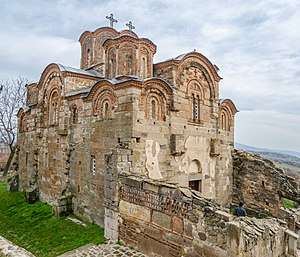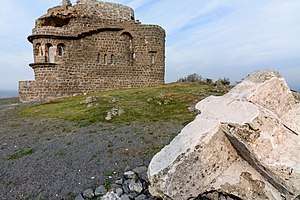Staro Nagoričane
Staro Nagoričane (Macedonian: Старо Нагоричане) is a municipality in northeastern North Macedonia between Kumanovo and Kriva Palanka, bordering Serbia to the north. The rural municipality of under 6,000 inhabitants is home to a number of significant places of interest including archaeological sites, monuments and memorials, and churches.
Get in
By car
Staro Nagoričane Municipality is situated along the A2/E871 highway which runs from Kumanovo in the west to the Bulgarian border to the east.
Get around
This rural municipality is best navigated by car. Some villages of interest like Mlado Nagoričane and Orah sit on or near the A2/E871 highway. At Mlado Nagoričane, the rural road R1207 runs north to the Serbian border. Along the way on this road are the villages of Staro Nagoričane, Dragomance, and Pelince, among others. At Dragomance, a rural road runs northeast to Žegljane and Kokino, among other villages.
See


- 🌍 Kokino (Кокино), village of Kokino. An important megalithic observatory site discovered in 2001 by archaeologist Jovica Stankovski. It is believed to represent an astronomical observatory and ceremonial site. The locale is approximately 3,800 years old and sits in beautiful scenery. It includes special stone markers used to track the movement of sun and moon on the eastern horizon. The observatory used a method of stationary observation, marking positions of the sun at the winter and summer solstice, as well as the equinox. The importance of the site, detailed by physicist Gjore Cenev, was confirmed by the US space agency NASA and it appeared fourth on a list of oldest observatories compiled by NASA. Look up information about this site prior to visiting as there are few explanatory resources to be found for visitors.
- 🌍 Church of Saint George (Црква „Св. Ѓорѓи“), village of Staro Nagoričane. A highly significant medieval church for both its architecture and frescoes. Saint George was first constructed in 1071 and reconstructed between 1313 and 1318 by the Serbian king at the time, Stefan Milutin. It features one main octagonal dome and four smaller domes. The lower part of the structure is made of large sandstone blocks while the upper part is made of rows of stone and brick. During the reconstruction period, the church's walls were painted with frescoes by Mihailo and Evtihij, among which are depictions of Stefan Milutin and his queen, Simonida. The fresco style is that of the Palaiologan Renaissance, which is characterised by the revival of ancient forms with iconographic innovations. Beside the church is a bell tower as well as some old graves.
- 🌍 ASNOM Memorial Center (Меморијален Центар АСНОМ), village of Pelince. The first plenary session of the Anti-fascist Assembly for the National Liberation of Macedonia (ASNOM) was held at Prohor Pčinjski Monastery, today in Serbia. ASNOM was the supreme legislative and executive people's representative body of the Macedonian state from 1944 until the end of World War II. The Assembly declared Macedonia the nation-state of Macedonians within Yugoslavia and proclaimed the Macedonian language as the official language of the Macedonian state. In 1947, the area including the monastery was transferred to the Serbian Socialist Republic. Following independence in 1991, Macedonia was often hassled by Serbia in holding its commemoration of the first ASNOM session at Prohor Pčinjski Monastery. Thus, this memorial center was built and the annual celebration occurs here. The building features a colorful facade of mosaics. The memorial center is only 2 km (1.2 mi) from Prohor Pčinjski Monastery.
- 🌍 Karpino Monastery (Карпински манастир), village of Orah. This 14th-century monastery is dedicated to the Presentation of the Virgin Mary. The present look of the monastery dates from the 16th and 17th centuries. Its church contains a valuable iconostasis with seven original icons dating from 1607. Some old frescoes are visible, though what can be seen is mostly from restoration in 1892. The bell tower of the monastery is among the more impressive in the country, built of stone blocks with decorative elements and capped by a dome and cross.
- 🌍 Zebrnjak (Зебрњак), village of Mlado Nagoričane. Situated on an elevated location, this grand monument was built in 1937 by the Serbs to commemorate the 25th anniversary of the Battle of Kumanovo during the Balkan Wars which saw the Serbs defeat the Turks. Considered the most monumental memorial in the central Balkans, it featured a tall three-sided pyramidal tower atop a large base. The remains of 678 Serbian soldiers are in the ossuary. In 1942, it was mostly destroyed by the Bulgarian army. Today, the base remains and can be visited. There are plans to reconstruct the monument fully but nothing has transpired as of yet. The roof offers sweeping views of the surroundings.
- 🌍
Kostoperska Rock (Костоперска Карпа), village of Mlado Nagoričane. This massive basalt rock formation is of volcanic origin. There is also important human history here, with archaeological findings from the Chalcolithic period. There were supposedly 40 churches once located around the rock; just two remain fully today, with another two in minor ruins.
- 🌍 Church of Saint George the Victorious (Црква „Св. Ѓорѓи Победоносец“). A few hundred meters northeast of the rock, Saint George dates from the 16th century. It was built of stone blocks and has a relatively detailed exterior. Its frescoes were done similarly to St George in Staro Nagoričane. The frescoes in the vault were completed in the 19th century, however, and the rich iconostasis was done in 1892. The church's courtyard contains a cemetery and detailed stone fountain.
- 🌍 Church of Saint Petka (Црква „Св. Петка“). On the foot of the southeast side of the rock is this 17th-century church. It frescoes were painted in 1628. The courtyard of the small church contains a cemetery.
- 🌍 Church of Saint George (Црква „Св. Ѓорѓи“), village of Žegljane. This small church was built of large stone blocks in a Byzantine revival style in 1867. In addition to its relatively elaborate exterior, it contains an iconostasis dating from 1874.
- 🌍 Zabelski Monastery (Забелски манастир), village of Nikuljane. This 14th-century monastery is home to a single church dedicated to the Dormition of the Theotokos (Virgin Mary). The church was destroyed following the beginning of Ottoman rule and rebuilt centuries later in the 1850s. It was built in the a style attributed to the Renzov family of large stone blocks and roof flat in the middle and pitched downward on both sides. An octagonal dome sits atop the church. The iconostasis within is made of wood. The monastery, situated in a forest area between the villages of Nikuljane, Staro Nagoričane, and Čelopek, also contains dormitories.
- 🌍 Church of Saints George and Nicholas (Црква „Св. Ѓорѓи и Св. Никола“), village of Orah. This post-Byzantine church is unique in that it is a double church dedicated to two saints with two separate entrances and two apses. The frescoes in the north nave are the oldest, dating from the church's construction period in the 16th or 17th century. The tall wooden iconostasis is mostly from 1893, with the exception of the doors in the south nave which are from the church's original iconostasis.
- 🌍 Šupliva Rock (Шуплива карпа), village of Strezovce. A megalithic anthropomorphic rock. Roughly the size of a small building, the rock is said to have been brought here by King Marko who balanced it on the tip of his finger, per local legend. The rock is visited by women having difficulties conceiving children as it is believed that entering the hole in the rock will help such a woman become pregnant.